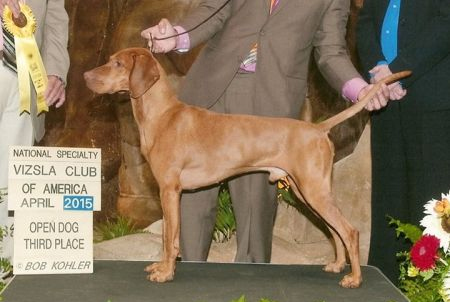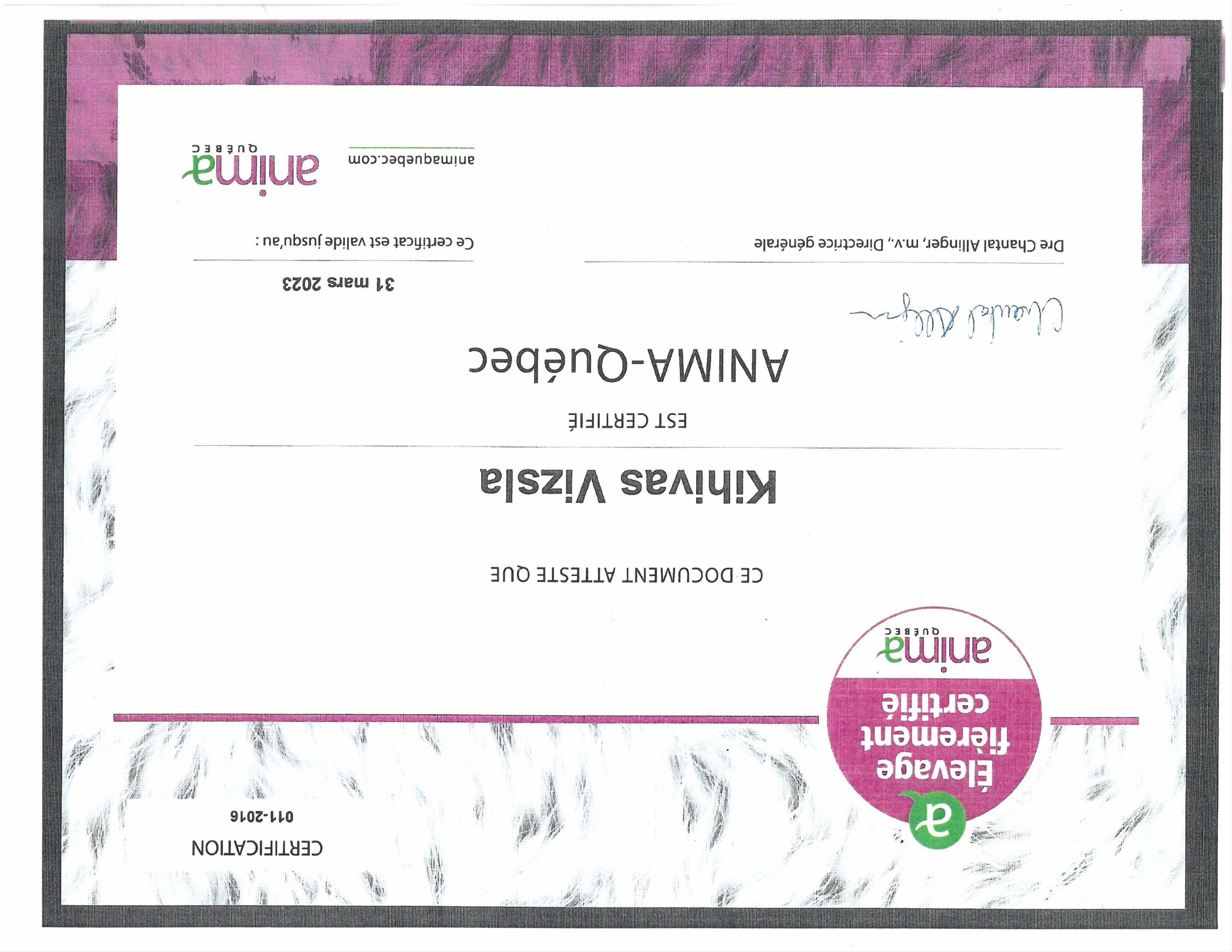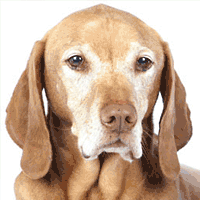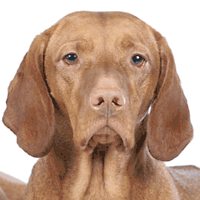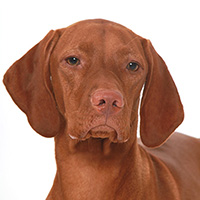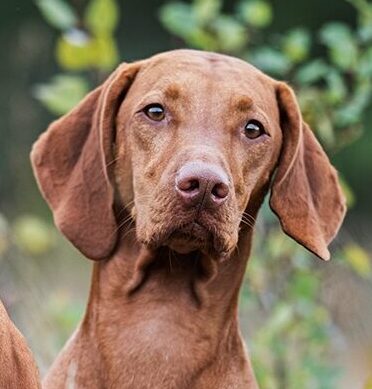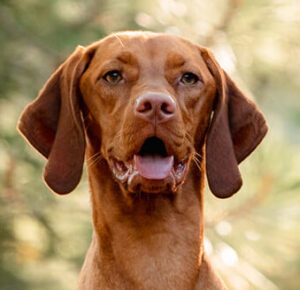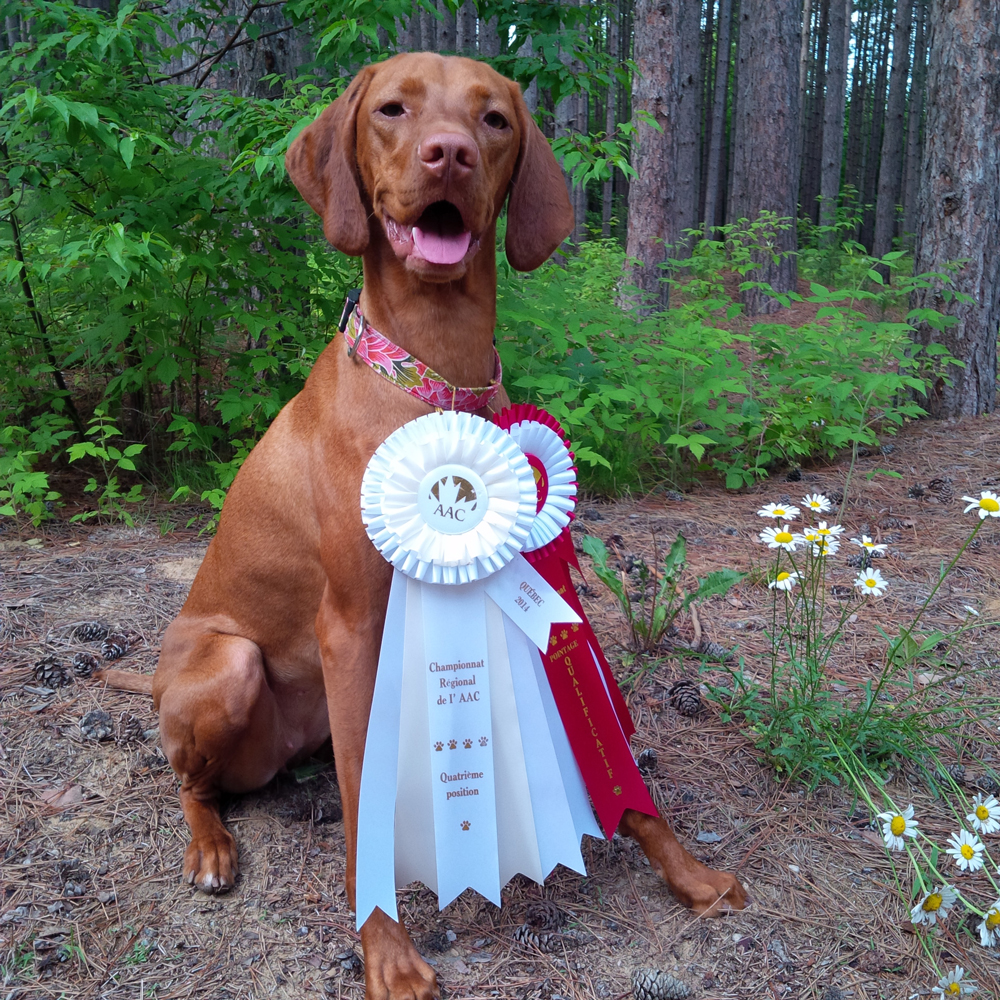Description
The ultimate goal, no doubt idealistic, of a breeder is to produce the perfect dog. Of course, there is no perfect humans nor dogs! At Kihivas, we are committed to being responsible and ethical breeders. Our priority is to produce healthy dogs with a great temper, in compliance with the standards of their breed, good workers and, most importantly, future great citizens and best friends. Our dogs are first and foremost life and family companions. They are also canine sports partners and some of them are also breeding dogs. Our breeding dogs are chosen for their temper, work ethic, conformity and are tested for the diseases related to their breed.
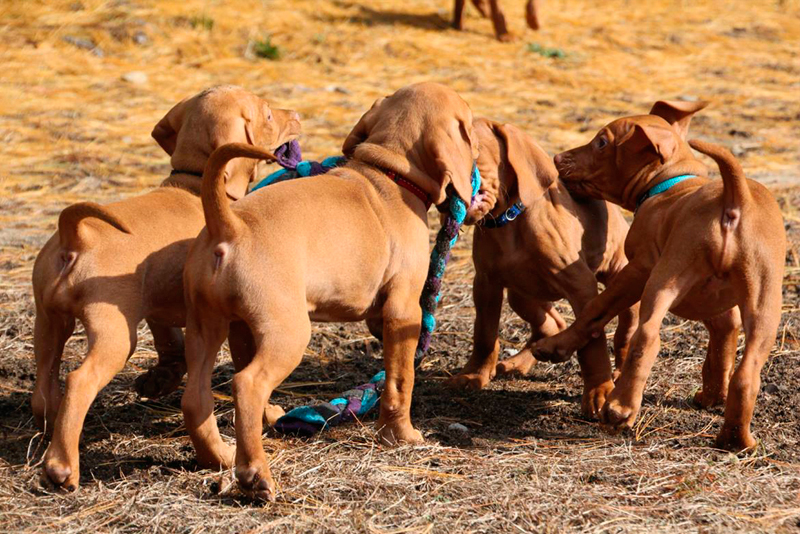
The puppies are born and raised in the house, in a family environment, following the Avidog program. From birth, they are handled and socialized. They benefit from early neurological stimulation programs with daily bio-sensitivity exercises and scent introduction. Prior to their departure at 9 weeks of age, the puppies are exposed to over 100 different humans and several different breeds of dogs, birds (dead and alive for hunting) and, if possible, cats. The puppies are exposed to a sound desensitization program, daily walks in the forest, introduction to different toys and modules to develop their skills and agility and are introduced to swimming (if the season allows).
The puppies are crate-trained, car-trained (and even camping!), and are introduced to housebreaking, basic commands and leash walking. The Kihivas puppies have an excellent start in their future active and athletic life worthy of their breed’s needs.
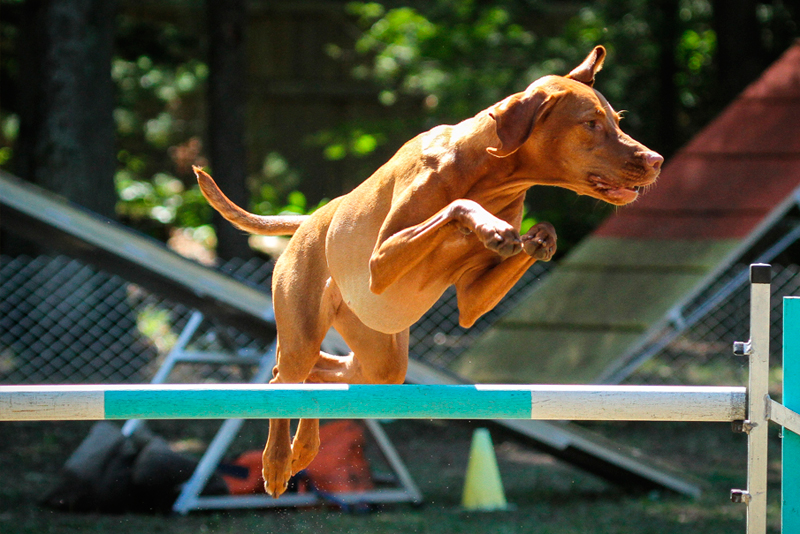
Puppies are registered with the Canadian Kennel Club and identified by microchip. They are dewormed, examined, vaccinated and their conformity and temperament are evaluated. They have their natural tail and dewclaws. They are guaranteed 36 months against malformations and hereditary diseases and behavioural problems. We offer a lifetime support and commitment to our puppies and their owners. They are sold with a purchase contract, a care guide and a promise of non-reproduction and are sold for $3000 + taxes.
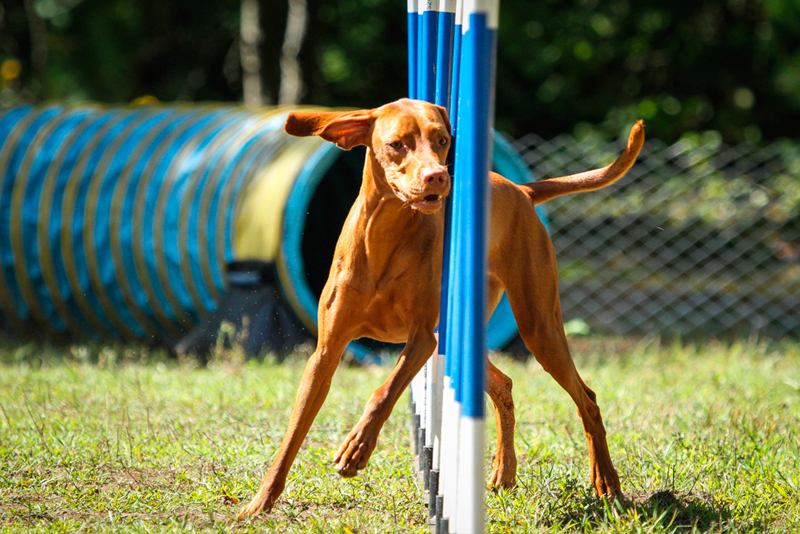
Our commitment to producing healthy puppies with excellent temperament requires that we collect specific genetic information on the health and temperament of all the dogs in our breeding program, not just our breeding stock. For this reason, we require that all our puppies be tested for genetic diseases between 24 and 30 months of age at the owner’s expense. These tests cost approximately $1000. This screening provides important information and includes examinations for certification by the Orthopedic Foundation for Animal: examination of the hips and elbows under anesthesia, cardiac examination by a cardiologist and an eye examination by an ophthalmologist.
We also ask all our families to complete a 100-question online Canine Behavioural Assessment & Research questionnaire about behaviours and the different ways the dog reacts to events when the dog is 12 months and 3 years old. These tests and questionnaires allow us to evaluate and monitor the health and temperaments of the puppies we produce to ensure that they meet our breeding goals and expectations as well as the expectations of their families.
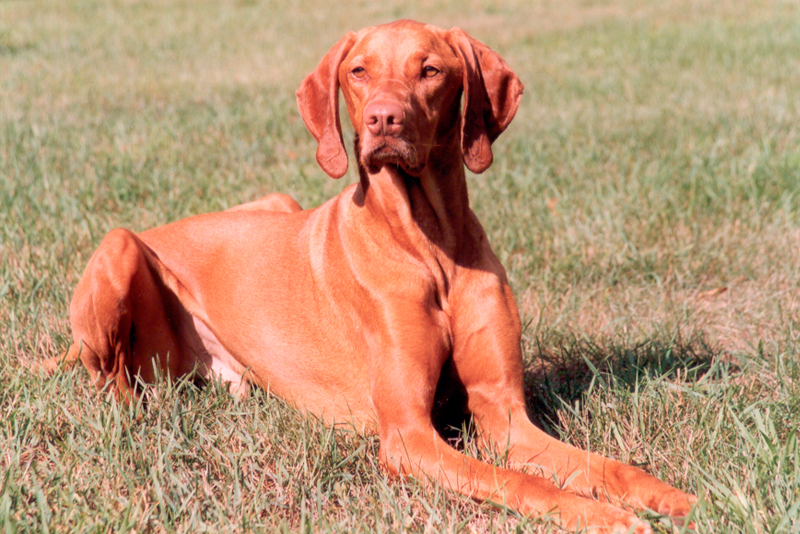
We have litters only occasionally. Our potential buyers are carefully selected to allow the puppies to have the best possible families. We prefer families with experience in performance and work (conformity, obedience, agility, hunting). However, we will consider all requests from active and prepared families. It is not uncommon to wait between 2 and 3 years before realizing a project to have a Kihivas puppy.
Before filling out our questionnaire… Did you ask yourself the following questions? Take the time to think about it and answer sincerely and frankly, as a family…
- Are you familiar with the activity, training and grooming (shedding) needs of our breed?
- Is your family ready to welcome a puppy and invest time in it? Yes, it will change your life! -Are you ready to modify your environment to make it safe for the puppy? (Include a crate in your family room décor, change the open garbage cans to those that activate with a pedal, put away your shoes, have a fence installed…)
- Are you ready to adjust your daily routine to include constant and vigilant supervision, daily walks, training and socialization?
- Are you willing to adjust your free time to include an evening or half-day on the weekend for classes, sports and dog activities?
- Are you ready to harmonize your vacations, hobbies and pastimes and choose destinations and activities where dogs are welcome?
- Are your children over 6 years old? Puppies and small children require a lot of management! Parents! Don’t assume that your child, even the most responsible and dedicated, will take care of the dogs’ needs, exercise and training alone! You will need to be actively involved!
- Not planning to start a family in the next year? You probably won’t have the time to juggle your new baby and baby dog training!
- Are you financially ready to take on the many expenses that come with a dog? And are you prepared for the unexpected expenses? Accidents, medication, care.
- Do you have realistic expectations about the puppy’s abilities and behaviours?
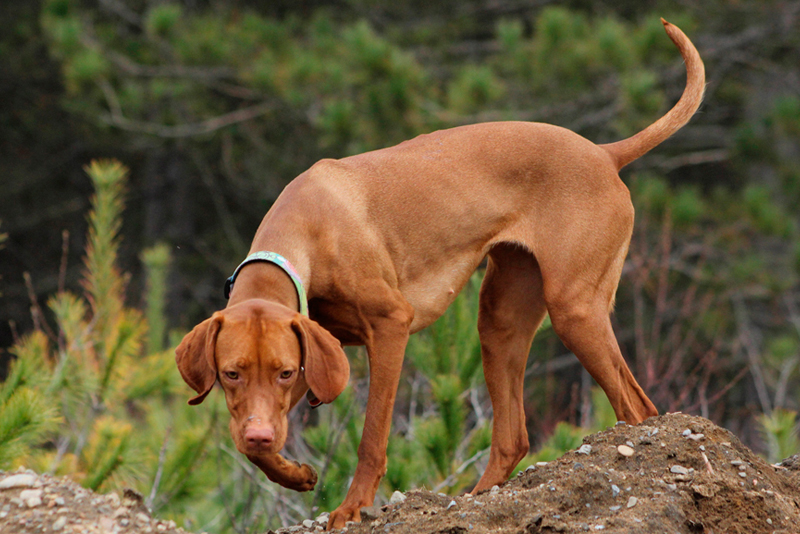
Please note that filling out this form does not guarantee a puppy for you nor does it obligate you to purchase a puppy from our kennel. We recognize that Vizslas are not a breed for everyone! Your honest and complete answers will help us determine if your family situation and expectations are a good match with one of our puppies. If your family is approved, the information you provide will help us select the puppy that best fits your profile and expectations.
The receipt of the form will be confirmed instantly with an automated email. We will personally answer you as soon as possible. Please note that we receive many, many requests! Only selected families will be invited for a visit.
We look forward to accompanying you and fulfilling your expectations in your project to expand your family!
Our kennel and our breeding hold the Anima-Québec certification, an external, independent and credible organization that:
- Attests the quality of the facilities of certified establishments;
- Ensures the excellence of the care given to the animals;
- Guarantees the well-being of the animals kept in these facilities;
- Gives the owner the means to make an informed choice when buying or keeping a pet.
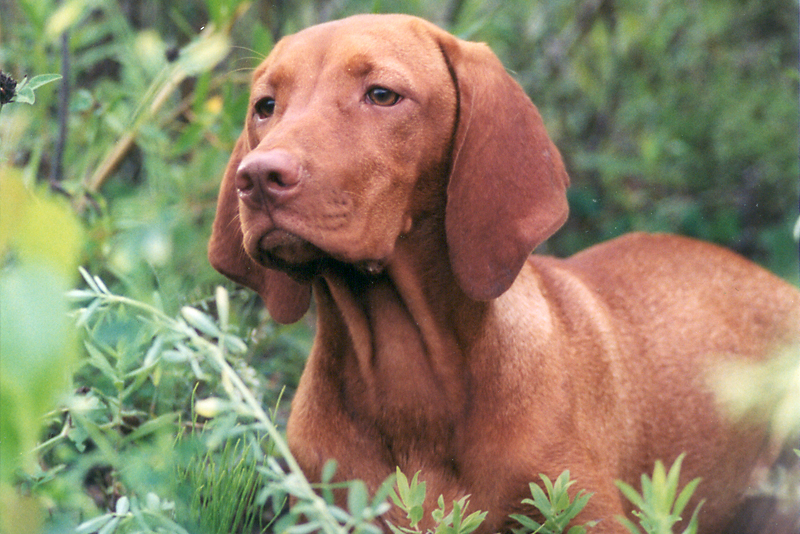
Historians’ opinions differ as to the development of the Hungarian pointer that goes by the name of Vizsla. Some claim to be able to trace the breed’s origins to 1,000 B.C. based on stone etchings from the period depicting a hunter, his falcon and a dog resembling the modern Vizsla. The dog is even mentioned in a 14th century treatise on falconry. Supporters of the breed’s long ancestry assert that the ancient dogs described in these documents were crossed with the Turkish yellow dog in the 18th century and that the breed was eventually standardized a few hundred years later.
Others maintain that the Vizsla is strictly a product of the 20th century and that it was created in Hungary as a result of crossbreeding of different hunting dogs, in the same manner as the versatile German hunting dogs were in the 19th century. It is believed that the short-haired Hungarian pointer is the result of a cross between the Weimaraner and various types of pointer.
In its native land, the Vizsla gained rapid popularity as a versatile hunting dog and its numbers skyrocketed. However, the two world wars had a devastating effect on the breed and it was thought that the Vizsla would disappear entirely. Fortunately, thanks to the efforts of a few dedicated breeders, the yellow pointer was reborn to become Hungary’s national dog.
At the end of World War II, refugees brought their hunting dogs with them and the Vizsla quickly became known throughout Europe. Then, with the growing popularity of the Weimaraner in North America in the 1940s, many hunters began considering the import of other versatile hunting breeds, particularly the short-haired Hungarian pointer. The first dogs arrived in the 1950s and, by 1960, the breed had become sufficiently popular to be recognized by the American Kennel Club, followed shortly after by the Canadian Kennel Club.
Origin and Purpose
The Vizsla (pronounced as if spelled VIZH-LA) originated in Hungary, where various records indicate its history as going back many centuries. It was the companion hunting dog of the early warlords and landed aristocracy who used it for general-purpose hunting. It was known in Hungary as the “yellow” pointer. In North America it is used primarily as an upland bird dog, where its excellent scenting and retrieving characteristics have been widely acclaimed. It is a strong swimmer and also retrieves well from water.
General Appearance
The Vizsla is a short-haired, medium-sized sporting dog. It conveys the impression of an alert, muscular, well-balanced animal with a distinctive and aristocratic appearance.
Temperament
The Vizsla is intelligent, calm, obedient, and easy to train. It is a sensitive dog that becomes attached to its owner and develops a strong but not overly aggressive protective instinct. In the field, the Vizsla is an eager, happy hunter that is at home on land and in the water.
Size
The standard size for the Vizsla, measured at the withers, is 23 inches (58 cm) for males and 22 inches (56 cm) for females. A dog of good bone and substance in this size range should weigh from 50-65lb. (22-29 kg). A bitch weighs about 10 lb. (4.536 kg) less. The length to height ratio should be approximately 1:1.
Coat and Colour
The hair of the Vizsla should be short and dense and should lie close to the skin. Each hair should be thick and elastic and the coat should have a glossy sheen.
The correct colour is a golden-rust, sometimes described as the golden colour of a bread crust. In some strains slightly lighter or darker shades may predominate. A white mark on the chest under 2 inches (5 cm) in diameter is permissible but not desirable.
Head
The Skull should be lean and muscular, with a median line down the forehead. The topline of the skull should be straight. The skull tends to be comparatively narrow in relation to its length, with that of the male being slightly wider. The occiput is slightly visible. The stop should be slight and sloping rather than abrupt.
- Muzzle: The muzzle should be approximately the same length as the skull. It should narrow, end squarely, and have clean straight lines.
- Mouth: The jaws should be strong with well-developed teeth meeting in a scissor-like or even bite. The lips should be smooth and well developed and cover the teeth tightly. The lips extend in a level line for 3/4 the length of the muzzle.
- Eyes: They should be almond shaped, bright and intelligent in appearance. The colour is in harmony with or darker than the colour of the coat; they should be moderately deep set. The eyelids close neatly and cleanly with no overlap. The nictitating membrane should not be overly exposed.
- Ears: The ears should be thin, silky and moderately tapered with rounded ends. They should just meet under the jaw, or reach to the corner of the mouth, but should not extend as far as the canine teeth. They should be set about 1/2 inch (1 cm) below the level of the skull and hang close to the cheeks.
Neck
The neck should be of medium length in proportion to the body. It must be well muscled, with a definite arch at the nape and widened to blend smoothly into the forequarters. The skin of the neck should be smooth and tight.
Forequarters
- Shoulders: The shoulder blade should be of medium length and must be held tightly in place. The angle formed by the shoulder blade (scapula) and the humerus should be approximately 90 degrees. The musculature should be firm, smooth and clearly defined.
- Upper-arm (humerus): The bone structure should be heavy, smooth and well covered by strong, firm muscles. The skin should be firm, pliable and smooth. The upper-arm should be equal in length to the shoulder blade (scapula).
- Lower-arm (radius and ulna): Strong big bones with good muscles. The legs should be straight whether viewed from the front or side. The angle at the elbow joint should be approximately 135 degrees.
- Pastern: The angle that the pastern makes with the lower leg should be nearly straight (about 175-180 degrees).
- Paws: The paws should be cat-like with tightly closed toes and big rough pads. The feet should be webbed. The nails should be short, firm and well curved, and their colour should be similar to that of the eyes, nose and coat. Dewclaws should be removed.
Body
- Topline: The topline should be broad and smooth and slightly arched over the loin and croup to the base of the tail; there is a slight depression at the juncture of the withers and the back.
- Chest: The chest should be deep, reaching down to the elbows and moderately broad. A cross-section of the chest is oval with well-sprung ribs, narrowing between the elbows to permit free and easy leg movement. Width of the chest between the forelegs is at least 6 inches (15 cm) for a male and 5 inches (13 cm) for a bitch.
- Loin: The loin should be broad, strong and well muscled.
- Croup: The croup should be heavily muscled and smoothly rounded to the base of the tail.
- Abdomen: The abdomen should be trim and neat with a moderate tuck-up.
Hindquarters
- Hip bone (pelvis): This is the framework that forms the basic support for the hind legs. The pelvic bones should be wide and strong. The musculature attaching to these bones should be very well developed to give strength to the hindquarters.
- Upper thigh (femur): This bone should be heavy, straight, round and smooth. Muscle attachments should be very powerful, broad and evenly distributed. The angle at the hip joint should be 90 degrees.
- Lower thigh (tibia and fibula): The lower thigh should be well muscled and the bones should be longer than the femur. The angle at the stifle joint should be from 110-120 degrees.
- Hocks: The angle at the hock joint should be from 125-130 degrees.
- Paws: Same as the front.
Tail
The tail-set is lower than on the other continental pointing breeds. In motion it is carried outstretched, at or above the horizontal level. A portion is docked, approximately 1/3, so that the tip of the shortened tail is level with the juncture of the upper and lower thigh. It should be thicker at the base than at the tip.
Gait
Viewed from the front, the dog’s legs should appear to swing forward in a free and easy manner, with no tendency for the feet to cross over or swing wide. Viewed from the rear, the gait should be true-tracking. The topline is level when the dog is in motion, while the head is carried high and the tail “flags” constantly at the proper level.
Faults
- Very nervous dogs should be heavily penalized.
- Very dark or very light coloured coat.
- Hare feet.
- Light yellow, green, blue or “pop” eyes.
- Throatiness.
- Dogs 10 lb. (4.536 kg) over or under the standard weight.
- Dewclaws not removed.
- Roached, hollow or camel backs.
- Too steep a croup.
- Undershot or overshot bites.
Disqualifications
- A dog 2 inches (5 cm) or more over or under the standard height.
- White markings over 2 inches (5 cm) on the chest or white markings anywhere other than the chest.
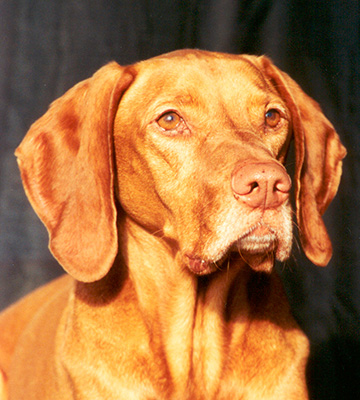
Jacob
ATChC, Bronze Award of Merit, Chukar’s Jacob Dan’s Pick, CD, AgX, OAC, NJC, NGC, CGC, CCGC, TT, RPT, UCC, AAC # 3137
Vizsla
Born September 9, 1994
Passed away September 23, 2008
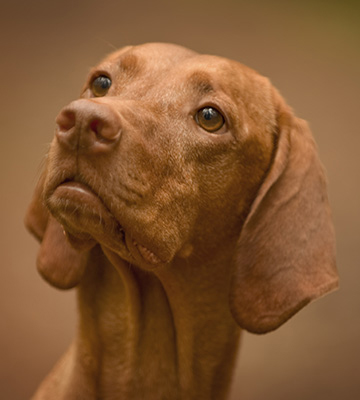
Kiva
ATChC, Kivalo Kiva Elso Kihivas,Gold Award of Merit, Expert Jumper & Steeplechase Silver, Expert Gamblers, Snooker & Team Realay Bronze, CGN, AgE, AgIJ, RPT, DD, AAC # 9249
Vizsla
Born February 26, 2003
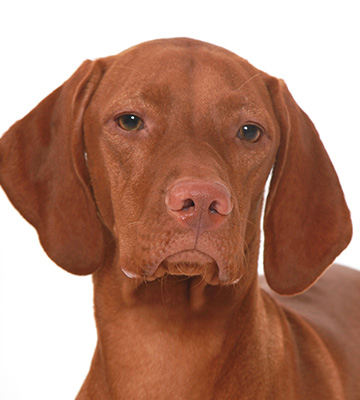
Ivie
Ch, ATChC Vihar EV Kettu Kihivas, CGN, CD, RA, AgX, AgXJ, AgSC, JTV, XPV, ATD, TD-ROM, RPT, AAC # 21197
Vizsla
Born August 19 2012
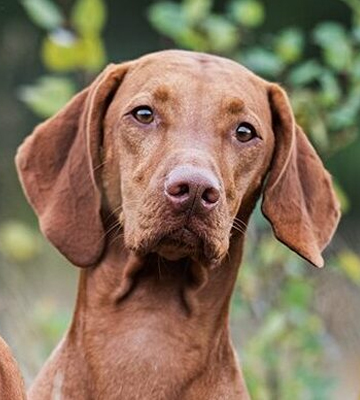
Curry
Ch, ATChC Kihivas Spice of Life, CGN, RN, AgI, AgX, JT, NP, ETD, RPT, AAC # 24637
Vizsla
Born September 1st, 2015
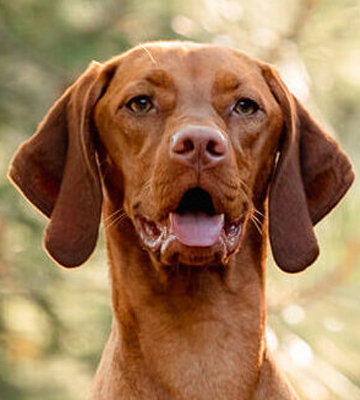
Lyla
Kihivas Wild Flower Power, CGN, AgN, AgNJ, ETD
Vizsla
Born June 10th 2019
July 2021 breeding
Puppies born Sept 12 2021: 1 female, 6 males.
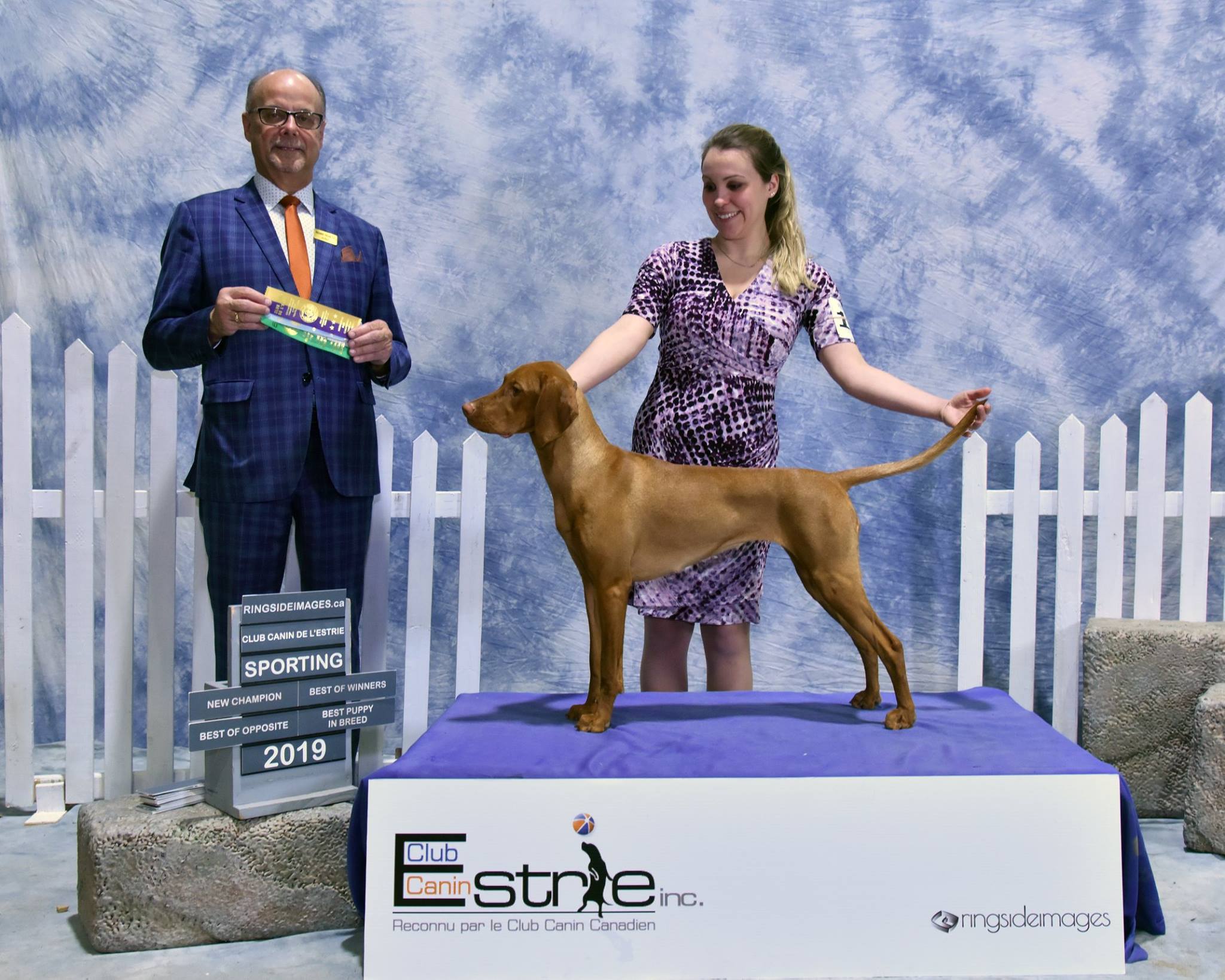

July 2021 breeding
Puppies born Sept 12 2021: 1 female, 6 males.


July 2021 breeding
Puppies born Sept 12 2021: 1 female, 6 males.


May 2021 breeding
Puppies born June 10th 2021: 2 females, 1 male.
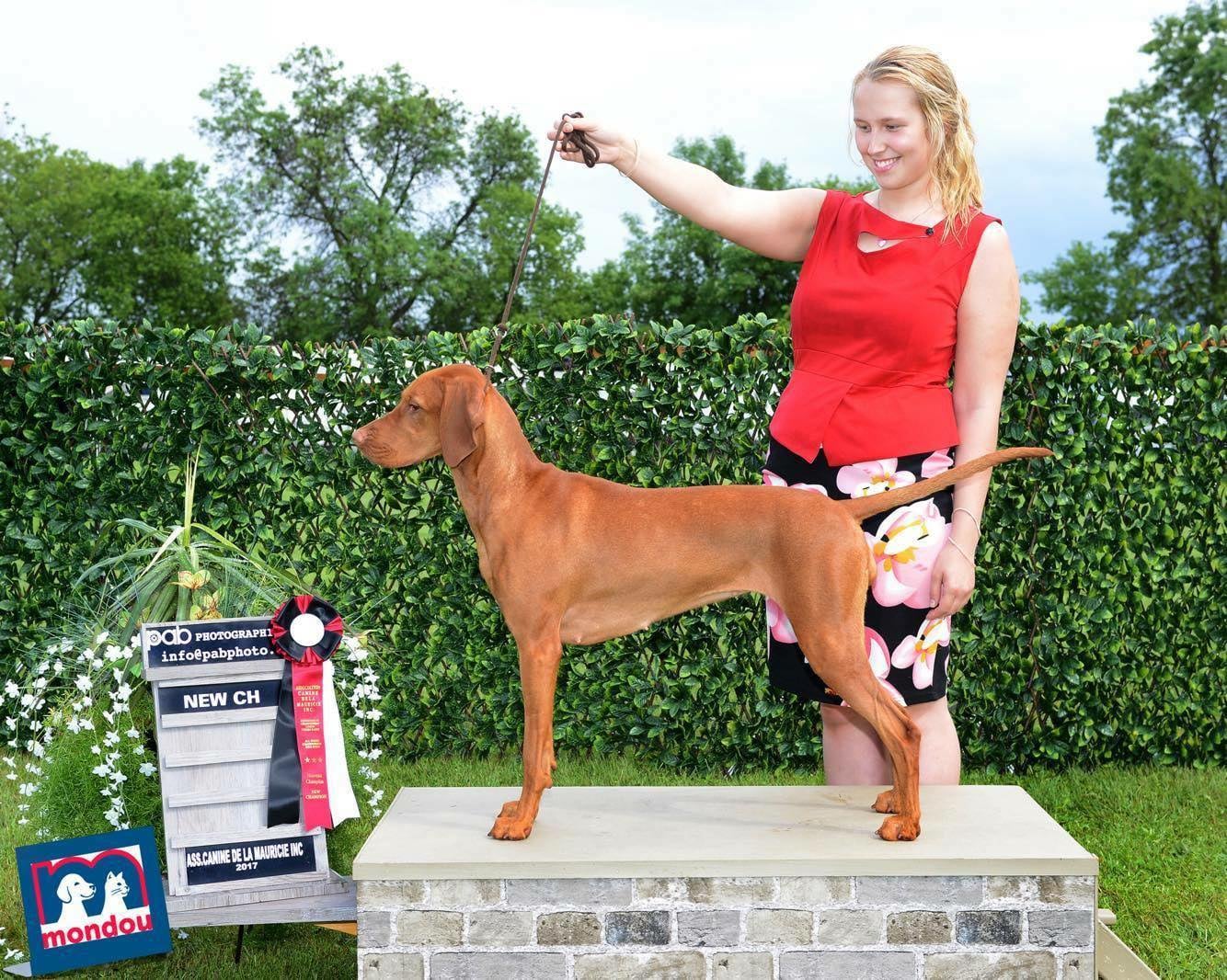
Anika
Ch, ATChC, Kihivas Anika Birdie Girl, GCN, RN, AgN, AgNJ, RPT
OFA Tested; hips, elbows, eyes, thyroide, heart
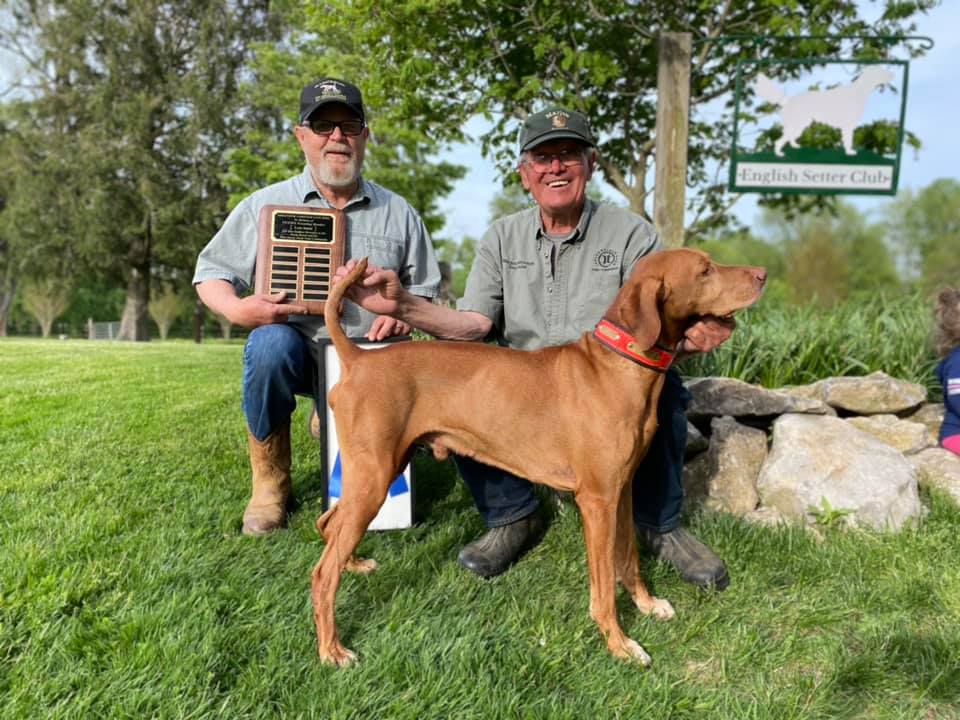
May 2019 breeding
Puppies born June 10th 2019: 4 females, 3 males.
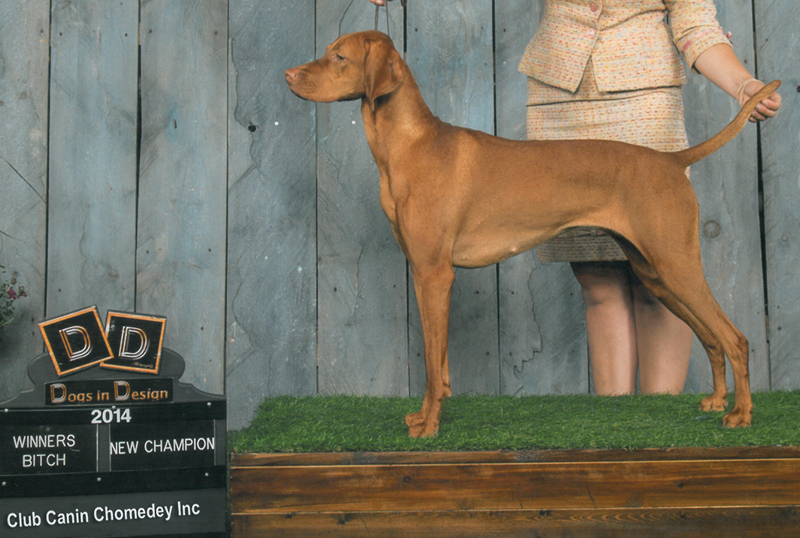
Ivie
UKC BIS, RBIS, Ch, CAN Ch, ATChC Vihar EV Ketto Kihivas, RPT, MTRDC
Testée OFA hanches, coudes, yeux, thyroïde, coeur
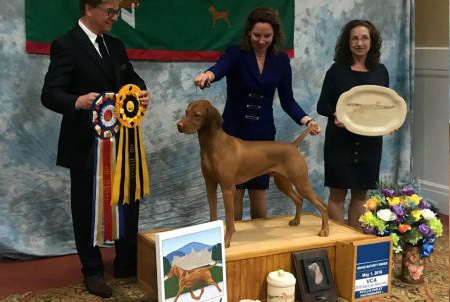
May 2018 Breeding
Puppies born June 6th 2018: 5 females, 2 males.

Ivie
UKC BIS, RBIS, Ch, CAN Ch, ATChC Vihar EV Ketto Kihivas, RPT, MTRDC
Testée OFA hanches, coudes, yeux, thyroïde, coeur
